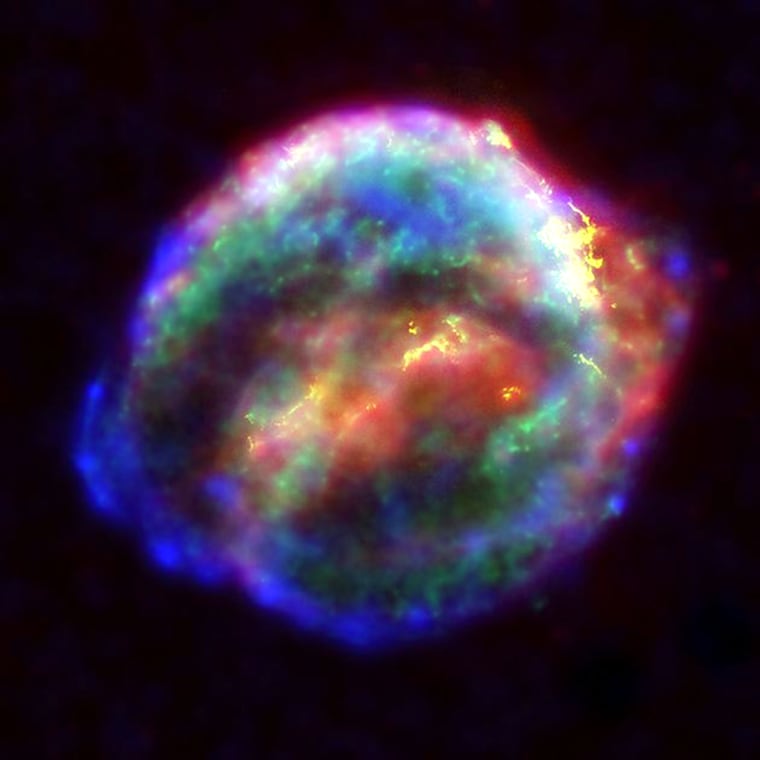Four hundred years ago this week, a previously unseen star suddenly appeared in the night sky. Discovered on Oct. 9, 1604, it was brighter than all other stars.
The German astronomer Johannes Kepler studied the star for a year, and wrote a book about it titled "De Stella Nova" ("The New Star"). In the 1940s scientists realized the object was an exploded star, and they called it Kepler's supernova.
No supernova in our galaxy has been discovered since the 1604 event.
Now the combined efforts of three powerful space observatories have produced a colorful picture of an expanding cloud of gas and dust that is a remnant of the supernova. The image is expected to help astronomers understand these violent and enigmatic events.
The scene is about 13,000 light-years away.
Up close
Last week, NASA announced three bursts of energy in faraway galaxies that might signal stars about to explode. It is how the most massive stars end their lives, and the result is often the formation of a black hole.
Spotting such supernovas in advance would be a boon to astronomers, who do not fully understand the death throes of a dying star. Supernovas create all the elements of the universe — the stuff of planets, plants and people. The stages of the explosions, modeled on computers, have been described as resembling a Lava Lamp.
Meanwhile, instead of observing what actually happens, scientists are left to study the remnants of Kepler's supernova and similar leftovers of relatively nearby explosions.
In the new picture, released Wednesday, a bubble-shaped shroud of gas and dust 14 light-years wide surrounds the exploded star. The bubble is expanding at 4 million mph (2,000 kilometers per second), astronomers said. It slams into interstellar material, setting up shock waves that agitate molecules and create light of various wavelengths.
The image combines data from the Chandra X-Ray Observatory, the infrared Spitzer Space Telescope, and visible light collected by the Hubble Space Telescope.
Color-coded
The infrared and X-ray data — invisible to the eye — have been colorized to make the image useful to astronomers.
"Multiwavelength studies are absolutely essential for putting together a complete picture of how supernova remnants evolve," said Ravi Sankrit of Johns Hopkins University.
Visible light is shown as yellow, revealing where the supernova shock wave is slamming into the densest regions of surrounding gas. Bright knots are thick clumps of material caused by instabilities that form behind the shock wave, researchers say. Thin filaments show where the shock wave passes through interstellar material that is more uniformly distributed and of lower density.
Infrared data, in red, shows microscopic dust particles that have been heated by the shock wave. Blue areas are X-rays that come from very hot gas or extremely high-energy particles squeezed into action. Green represents lower-energy X-rays from cooler gas.
"When the analysis is complete, we will be able to answer several important questions about this enigmatic object," said William Blair, also of Johns Hopkins and co-leader of the study with Sankrit.
Kepler's supernova remnant is just one of several under study. One thing is clear: Material that a dying star sends into space takes on a variety of dramatic shapes. And interestingly, our own solar system is thought to reside in a huge cavity, riddled with pockets and tunnels all carved out by exploded stars, long ago.
Questions and answers
Here are some questions and answers related to Kepler's supernova, provided by the Space Telescope Science Institute, which operates Hubble for NASA:
How often does a star explode as a supernova?In a typical galaxy like our Milky Way, a supernova pops off about every 100 years. From our earthly vantage point, we cannot see every supernova that occurs in our galaxy because interstellar dust obscures our sight. The Kepler supernova, which occurred 400 years ago, is the last supernova seen inside the disk of our Milky Way. So, statistically, we are overdue for witnessing another stellar blast. Curiously, the Kepler supernova was seen to explode 30 years after Tycho Brahe witnessed a stellar explosion in our galaxy. The nearest recent supernova seen was 1987A, which astronomers spied in 1987 in our galactic neighbor, the Large Magellanic Cloud.
Why are supernovas important?All stars make heavy chemical elements like carbon and oxygen through a process called nuclear fusion, where lighter elements are fused together to make heavier elements. Many chemical elements heavier than iron, such as gold and uranium, are produced in the heat and pressure of supernova explosions. These heavy elements enrich the interstellar medium, providing the building blocks for stars and planets, like Earth.
What kind of star produces a supernova?Two types of stars generate supernovas. The first type, called a Type Ia supernova, is produced by a star's burned-out core. This stellar relic, called a white dwarf, siphons hydrogen from a companion star, thereby making it 1.4 times more massive than our sun [called the Chandrasekhar limit]. This excess bulk leads to explosive burning of carbon and other chemical elements that make up the white dwarf. A star that is more than eight times as massive as our sun generates the second type, called Type II. When the star runs out of nuclear fuel, the core collapses. Then the surrounding layers crash onto the core and bounce back, ripping apart the outer layers.
The supernova was first seen in 1604. Is that when the star exploded?No, the explosion occurred thousands of years ago, but the light of the explosion only reached Earth in 1604. Why did it take so long for the light to reach us? It has to do with distance. The supernova is about 13,000 light-years away. A light-year is the distance that light can travel in a year — about 6 trillion miles (10 trillion kilometers). Because the supernova is 13,000 light-years away, it took 13,000 years for light from the exploded star to reach Earth.
